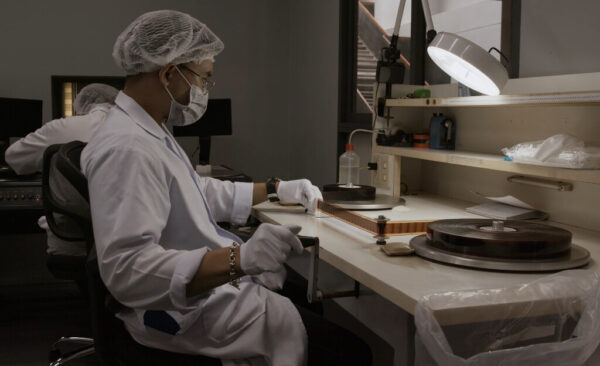NR | 1h 59min | Documentary, Film History | 5 March 2023 (Spain/Canada)
Divided into four distinct chapters, “Film, the Living Record of Our Memory” (FTLROOM) delves into an overlooked and largely unknown area of movie history that, even many of those who consider themselves industry experts, will discover they are woefully uniformed.
Wasting zero time, writer and director Ines Toharia presents images of multiple film cans being opened and revealing their content. Most of it is nothing but dust, something that happens to film stock left too long in hot and humid storage rooms. The bulk of these are silent films that went ignored so long—80 percent of all ever produced are forever lost.
Sold for Scrap
Then, there are “talkie” productions released from the late 1920s through the late 1940s that were purposefully sold off by various studios and melted down for their silver content. It was the mindset at the time that once a movie completed a theatrical run, it had exhausted its ability to generate revenue, and this “recycling” was just a way to wring out a few more bucks.
 Samples of film deterioration in “Film, the Living Record of Our Memory.” (El Grifilm Productions)
Samples of film deterioration in “Film, the Living Record of Our Memory.” (El Grifilm Productions)It didn’t help matters that all of these movies were made from nitrate stock, a volatile and highly flammable substance that was discontinued in 1950.
Easily, the most disheartening portion of this opening salvo began in the 1940s when the Nazis, not content with conquering most of Eastern Europe, confiscated the artworks of these countries. When it became clear they were going to lose the war, the Nazis began destroying the thousands of films in their possession and, if not for the intervention of the Russians, they would have succeeded in full.
This segment dovetails nicely into another profiling of the early collectors; those who recognized the future cultural significance of the film medium. More pioneers and preservationists than hoarders, these benevolent individuals put great effort into saving any and all movies they could locate. One in particular, Cinémathèque Française founder Henri Langlois, was able to rescue two early German classics: “Faust” (1926) and “Nosferatu” (1922).
Revealing Home Movies
Next, Toharia throws us a hard curve ball by including a truncated and illuminating history of amateur or “home” movies and how they figure into the title of this film. In addition to things those of a certain age associate with home movies (vacations at the beach, birthday celebrations), Toharia includes clips of those shot in post-Kristallnacht Vienna and a 1938 film of Depression-era field workers that are highly reminiscent of what would be seen in “The Grapes of Wrath” two years later.
Arguably, the most visceral portion of the entire production are the home movies of Japanese Americans getting off of overstuffed train cars and being led to internment camps. In America. It’s not a good look to be sure but, as it is often said, those who ignore history are doomed to repeat it.
The first portion of the third quarter of “FTLROOM” is dedicated to the ongoing and endless search for lost features and shorts not only in the United States and Europe, but also in the Far East and Africa alongside the bios of some of the early pioneers in those regions. It is truly inspirational and eye-opening stuff.
Talking Back to the Screen
In what is the most unique and lighthearted but revealing passage, Toharia profiles the “Mostly Lost” film festival. Held annually since 2007 at a branch of the Library of Congress in Culpeper, Virginia, it includes 150 invited scholars and movie buffs that are shown portions of recovered silent films and are called on to audibly identify clues contained within the mysterious frames. It’s the only time that talking during a movie is encouraged.
 A technician at work preserving deteriorating films in “Film, the Living Record of Our Memory.” (El Grifilm Productions)
A technician at work preserving deteriorating films in “Film, the Living Record of Our Memory.” (El Grifilm Productions)Fittingly, the final 30 minutes concentrates on the global community of film restorers. Selfless, dedicated, and eminently patient, these professionals are charged with taking decimated, often unwatchable bits and pieces of celluloid and bringing them back to life, or as close to life as possible.
Because of their limited time and funds, they also have the arduous, unenviable task of choosing what to save and what must be left to wither away.
The most surprising aspect of the restoration segment is what’s in store for the future of filmmaking in general and the manner in which it will be shot and eventually preserved. To make a comparison without giving too much away, it lends credence to people who prefer the sound of analog vinyl records over digital CDs.
Needless to say, “FTLROOM” is absolutely essential viewing for movie fans, scholars, students, historians, and anyone interested in how important it is to take care of the past.
 A documentary about an overlooked and largely unknown area of movie history is explored in “Film, the Living Record of Our Memory.” (El Grifilm Productions)
A documentary about an overlooked and largely unknown area of movie history is explored in “Film, the Living Record of Our Memory.” (El Grifilm Productions)Presented in English and subtitled Spanish, Italian, French, Catalan, and Arabic.
‘Film, the Living Record of Our Memory’
Documentary
Director: Ines Toharia
Running Time: One hour, 59 minutes
MPAA Rating: Not Rated
Release Date: March 5, 2023
Rating: 4.5 out of 5
 RSS Feed
RSS Feed















 March 4th, 2023
March 4th, 2023  Awake Goy
Awake Goy  Posted in
Posted in  Tags:
Tags: 













